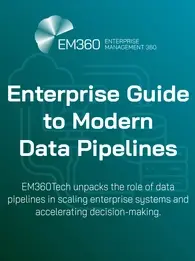

Danny Flamberg is a Principal at Opera Solutions leading the Omnichannel Marketing team and the author of Dancing Through the Digital Revolution. Danny is also a member of the EM360 Advisory Board.
Opinions expressed by EM360 contributors are their own.
Big Data is more aspiration than reality for most marketing organisations. Broad consensus on the strategic value of Big Data gives way to the myriad of nuts-and-bolts technical issues necessary to structure a data ecosystem and bring crisp data-driven insights to life in personalised communications.
You can assess an organization's readiness to leverage Big Data by analyzing an organization's capabilities across seven key areas:
Strategic Vision is the acceptance of Big Data as a critical contributor to meeting business objectives. Understanding the C-Suite commitment and buy-in is the first step, followed by an allocation of time, focus, priority, resources and energy. It's easy to talk the talk.
Look for the frequent disconnect between senior executives who make strategic choices and working level data scientists, data analysts and data-centric marketers who actually do the work. Too often decisions are made without sufficient working-level inputs. Often, the view from the top and the view from the middle are radically different.
Data Ecosystem can be a stumbling block or an enabler. Many companies are trapped by legacy systems and sunk investments. Not every firm has a clear future vision mapped to the existing plumbing. Frequently there is friction between the technical stewards of the IT landscape and the business users who increasing hold related budgets. In many cases, the forward vision is a collection of work-arounds. Adding to the confusion are 3500+ companies offering all manner of tech solutions making similar claims, using similar language and offering similar deals.
Data Governance refers to understanding data sources, having a plan for ingestion, normalization, security and prioritization. This requires a combination of agile security measures, a clearly defined permissioning regime and pathways for access and control. Governance rules balance privacy and compliance with flexible use and re-use of data. Too often these issues are muddled or strung together by circumstances rather than reflecting well-designed policies and protocols.
Applied Analytics is an indicator of how well an organization has deployed analytics resources and is able to bring artificial intelligence and machine learning to bear. The critical questions are: does an organization have enough analytics resources and how are they being deployed? Are analytics embedded in marketing and strategic workflows, or tapped on an ad hoc basis? Are analytics driving key business decisions and driving efficiencies in acquisition, retention, cost reduction and loyalty?
Technology Infrastructure assesses the software and data structures used to ingest, process, cleanse, secure and update the torrents of data flowing into most companies. Key indicators are the level of automation and capabilities to normalize data sets, resolve individual identities, create meaningful segments and continuously take in and apply new real-time data. Other positive indicators are alliances with ESPs, marketing automation and cloud computing suppliers.
Use Case Development measures the ability of a firm to actually use the data they collect and process. Can they identify “best” customers; predict next best offers or nurture likely loyalists? Do they have industrialized mechanisms to create personalized messages, undertake micro-segmentation, respond to behaviour in mobile or social media or create multiple content campaigns delivered across many channels?
Embracing Math Men is an indicator of corporate culture; a measurement of a organizations genuine appetite to explore, adopt and acquire new approaches and new technologies. Everyone spouts the rhetoric of digital and data transformation.
But many fear WMDs (weapons of math disruption).
Far fewer invest the time, resources and cash to make data-centricity a fundamental corporate asset. Getting to Big Data readiness can be long, costly and frustrating. It always requires significant changes in attitudes, workflows and technology. This indicator measures an organization's true commitment to future data use goals.
Realizing the benefits of Big Data is an exercise in change management. These seven criteria enable us to get a clear-eyed view of where on the transformation spectrum a given organization falls. Understanding where you are versus where you want to be can be a useful, if sobering exercise.













Comments ( 0 )